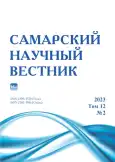Планктонная альгофлора малых рек в условиях города (на примере рек Мирожки и Псковы, г. Псков, Псковская область)
- Авторы: Дрозденко Т.В.1
-
Учреждения:
- Псковский государственный университет
- Выпуск: Том 12, № 2 (2023)
- Страницы: 30-34
- Раздел: Биологические науки
- URL: https://journals.rcsi.science/2309-4370/article/view/253016
- DOI: https://doi.org/10.55355/snv2023122104
- ID: 253016
Цитировать
Полный текст
Аннотация
В статье представлены результаты исследований планктонной альгофлоры р. Мирожки и р. Псковы, выполненных в раннеосенний период 2019 г. Таксономический состав р. Мирожки включал 107 видовых и внутривидовых таксонов микроводорослей, р. Псковы – 76 видовых таксонов водорослей из 7 отделов: Bacillariophyta, Cyanobacteria, Chlorophyta, Ochrophyta, Cryptophyta, Euglenozoa, Miozoa. Основу флористического комплекса в обеих реках составляли диатомовые и зеленые водоросли. В видовое богатство альгофлоры р. Мирожки также видимый вклад вносили представители отдела Ochrophyta. Степень флористического сходства фитопланктонных сообществ рек Мирожки и Псковы, рассчитанная с помощью индекса Сьеренсена–Чекановского, составила 55,7% (общими для рек был 51 вид микроводорослей). Средняя численность фитопланктона в р. Мирожке составляла 891,9 тыс. кл./л, а в р. Пскове – 199,6 тыс. кл./л, биомасса – 366,9 мкг/л и 79,6 мкг/л соответственно. Согласно эколого-географическому анализу в обеих реках преобладали пресноводные широко распространенные планктонные формы микроводорослей, предпочитающие слабощелочные воды. По отношению к загрязнению органическими веществами в реках превалировали бета-мезосапробионты (38,5% – р. Мирожка; 41,8% – р. Пскова), что указывает на умеренную загрязненность исследуемых водотоков. Средний индекс сапробности р. Мирожки и р. Псковы составил 2,1 и 1,9 соответственно, что позволяет отнести воды исследуемых водотоков к 3 классу качества – умеренно загрязненным.
Полный текст
Открыть статью на сайте журналаОб авторах
Татьяна Викторовна Дрозденко
Псковский государственный университет
Автор, ответственный за переписку.
Email: tboichuk@mail.ru
кандидат биологических наук, доцент кафедры экологии и экспериментальной биологии, старший научный сотрудник лаборатории комплексных экологических исследований
Россия, ПсковСписок литературы
- Охапкин А.Г., Юлова Г.А., Старцева Н.А. Состав и эколого-флористическая характеристика фитопланктона малых водоемов урбанизированных территорий (на примере города Нижнего Новгорода) // Ботанический журнал. 2002. Т. 87, № 2. С. 78–88.
- Трифонова И.С., Генкал С.И., Павлова О.А. Состав и сукцессия диатомовых водорослей в планктоне городских водоемов Санкт-Петербурга // Ботанический журнал. 2003. Т. 88, № 11. С. 42–52.
- Павлова О.А. Структура фитопланктона малых озер в условиях урбанизированного ландшафта (на примере Суздальских озер г. Санкт-Петербурга): автореф. … канд. биол. наук: 03.00.16. СПб., 2004. 24 с.
- Коновалова О.А. Фитопланктон как индикатор состояния водных экосистем городских ландшафтов (на примере г. Омска): автореф. … канд. биол. наук: 03.02.08. Омск, 2011. 18 с.
- Chorus I., Wesseler E. Response of the phytoplankton community to therapy measures in a highly eutrophic urban lake (Schlachtensee, Berlin) // Internationale Vereinigung für Theoretische und Angewandte Limnologie: Verhandlungen. 1988. Vol. 23, iss. 2. P. 719–728. DOI: 10.1080/ 03680770.1987.11899699.
- Anneville O., Ginot V., Angeli N. Restoration of Lake Geneva: expected versus observed responses of phytoplankton to decreases in phosphorus // Lakes & Reservoirs: Science, Policy and Management for Sustainable Use. 2002. Vol. 7, iss. 2. P. 67–80. doi: 10.1046/j.1440-169x.2002.00179.x.
- Дрозденко Т.В., Смирнова А.Н. Фитопланктон как показатель экологического состояния некоторых прудов г. Пскова // Метеорологический вестник. 2017. Т. 9, № 2. С. 69–73.
- Водные объекты Санкт-Петербурга / под ред. С.А. Кондратьева, Г.Т. Фрумина. СПб., 2002. 348 с.
- Ташлыкова Н.А. Состав и структура фитопланктона прибрежной и центральной частей оз. Арахлей (Забайкальский край) в весенне-летний сезон 2017 г. // Принципы экологии. 2018. № 3. С. 75–90. doi: 10.15393/j1.art. 2018.7403.
- Дрозденко Т.В., Антал Т.К. Оценка качества воды устья реки Великой по показателям фитопланктона // Вестник Астраханского государственного технического университета. Серия: Рыбное хозяйство. 2021. № 1. С. 51–60. doi: 10.24143/2073-5529-2021-1-51-60.
- Дрозденко Т.В., Волгушева А.А. Фитопланктон и качество воды озера Кучане (Псковская область, Россия) // Поволжский экологический журнал. 2021. № 3. С. 251–261. doi: 10.35885/1684-7318-2021-3-251-261.
- Pourafrasyabi M., Ramezanpour Z. Phytoplankton as bio-indicator of water quality in Sefid Rud River, Iran (South of Caspian Sea) // Caspian Journal of Environmental Sciences. 2014. Vol. 12, № 1. P. 31–40.
- Дрозденко Т.В., Михалап С.Г. Фитоперифитон устья реки Мирожки как показатель качества воды // Псковский регионологический журнал. 2017. № 2 (30). С. 117–129.
- Садчиков А.П. Методы изучения пресноводного фитопланктона: методическое руководство. М.: Университет и школа, 2003. 158 с.
- Guiry M.D., Guiry G.M. AlgaeBase [Internet] // https:// www.algaebase.org.
- Шмидт В.М. Статистические методы в сравнительной флористике. Л.: Ленингр. ун-т, 1980. 176 с.
- Sladecek V. System of water quality from biological point of view // Achieves für Hydrobiologie – Beiheft Ergebnisse der Limnologie. 1973. Vol. 7, № 1. P. 1–218.
- Комулайнен С.Ф., Чекрыжева Т.А., Вислянская И.Г. Альгофлора озер и рек Карелии. Таксономический состав и экология. Петрозаводск: Карельский научный центр РАН, 2006. 81 с.
- Судницына Д.Н. Альгофлора водоемов Псковской области. Псков: ООО «Логос Плюс», 2012. 224 с.
- Оксиюк О.П., Жукинский В.Н., Брагинский Л.П., Линник П.Н., Кузьменко М.И., Кленус В.Г. Комплексная экологическая классификация качества поверхностных вод суши // Гидробиологический журнал. 1993. Т. 29, № 4. С. 62–76.








